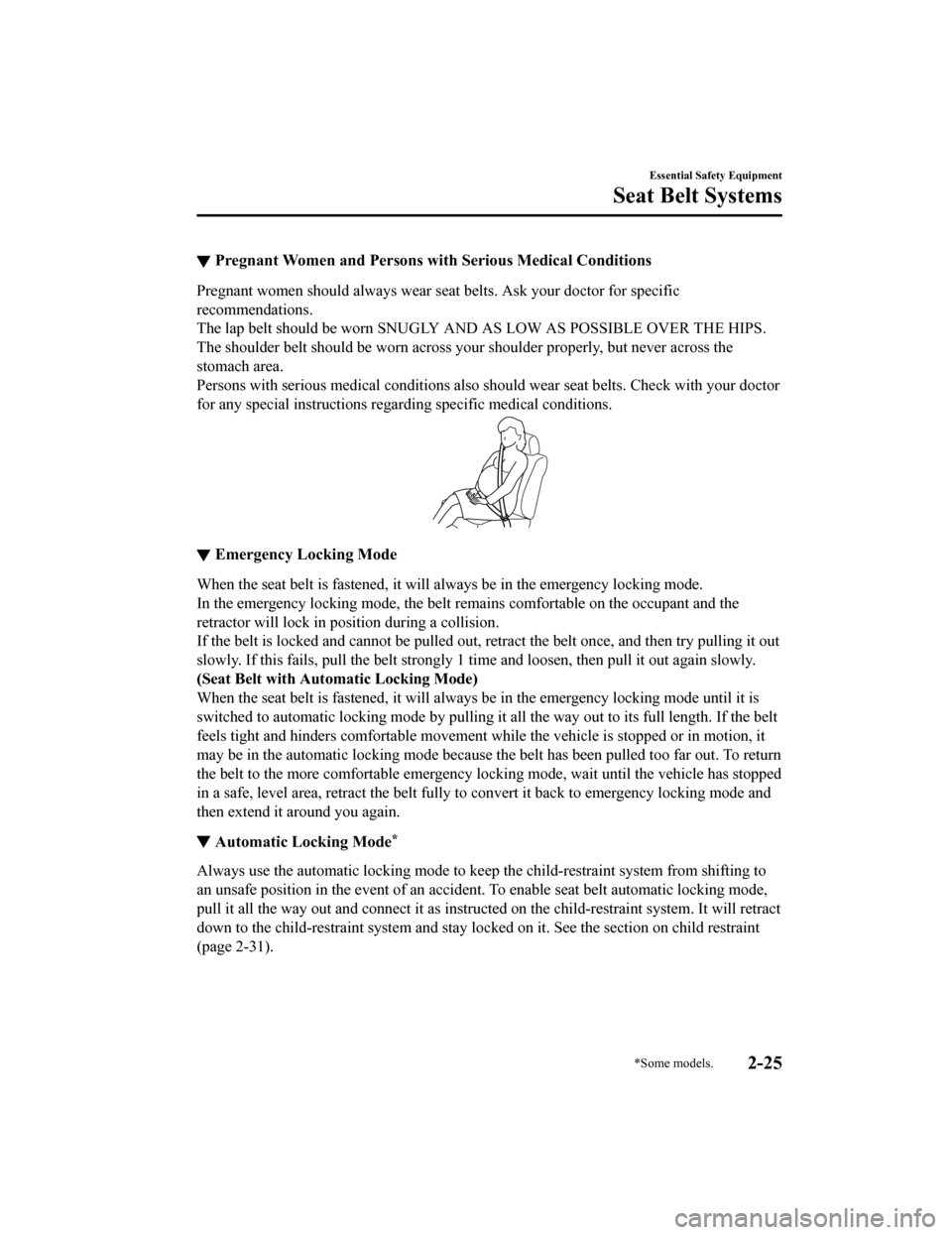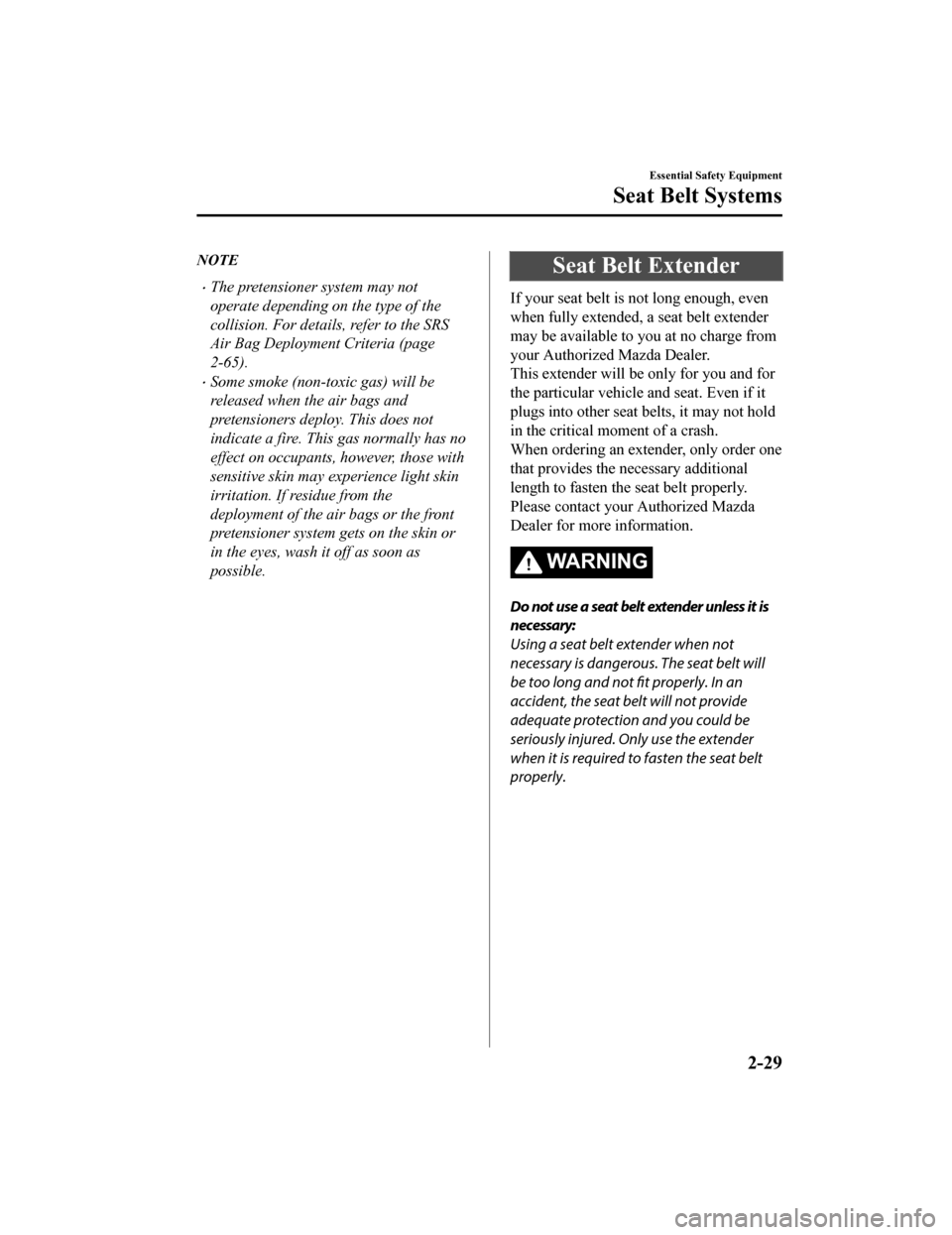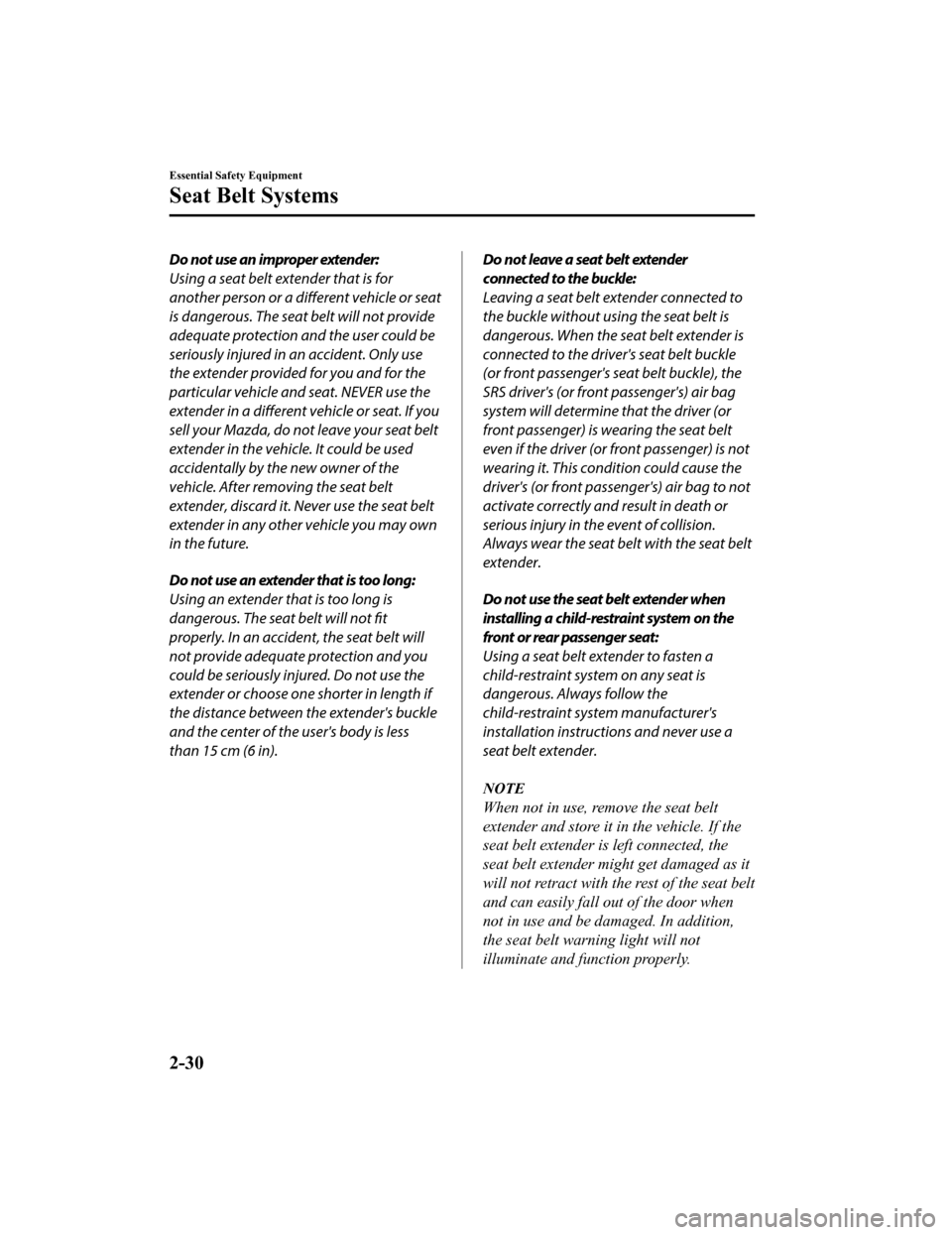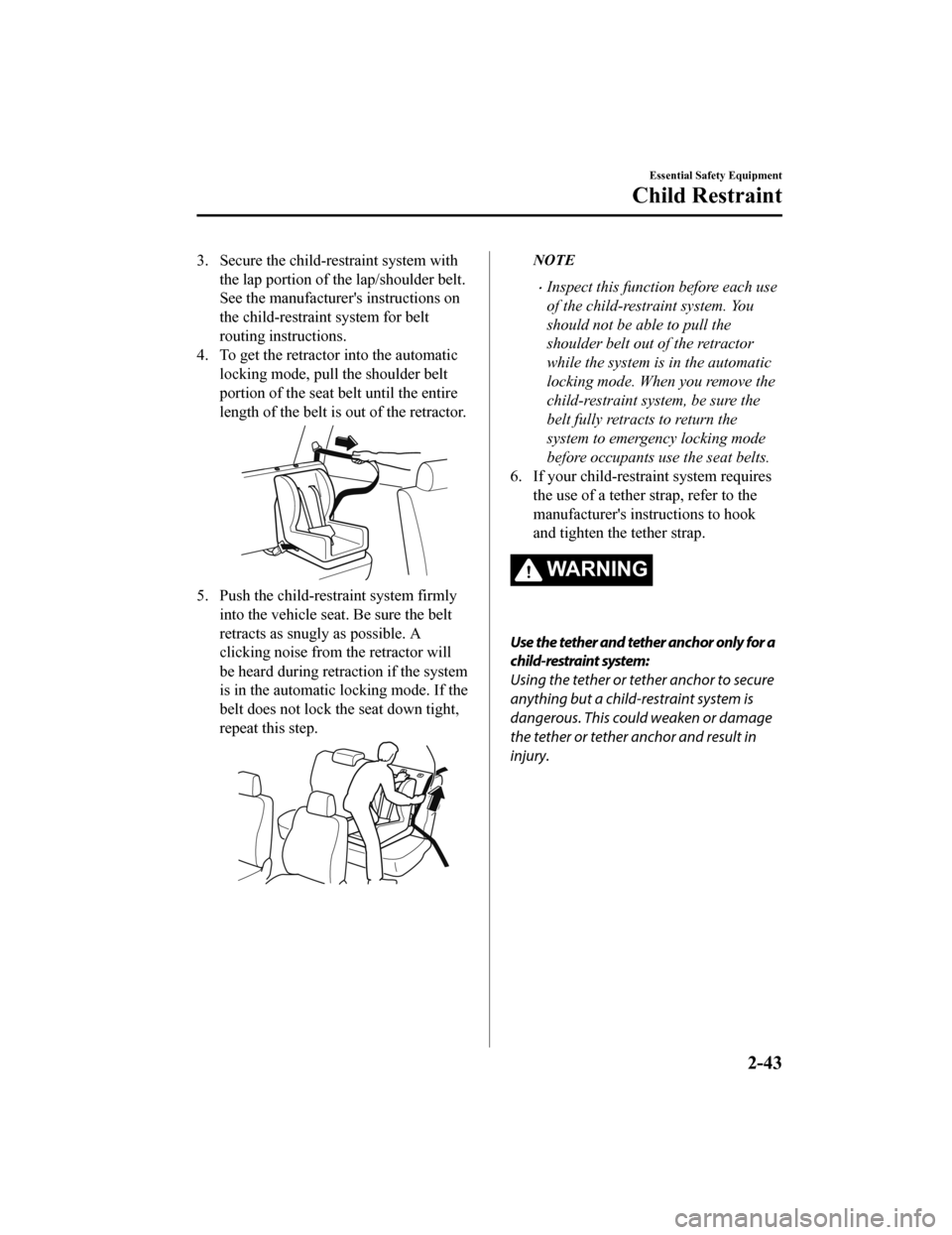length MAZDA MODEL 6 2020 Owner's Manual (in English)
[x] Cancel search | Manufacturer: MAZDA, Model Year: 2020, Model line: MODEL 6, Model: MAZDA MODEL 6 2020Pages: 702
Page 39 of 702

▼Pregnant Women and Persons wi
th Serious Medical Conditions
Pregnant women should always wear seat belts. Ask your doctor f or specific
recommendations.
The lap belt should be worn SNUGL Y AND AS LOW AS POSSIBLE OVER THE HIPS.
The shoulder belt should be worn across your shoulder properly, but never across the
stomach area.
Persons with serious medical conditions also should wear seat b elts. Check with your doctor
for any special instructions regarding specific medical conditi ons.
▼Emergency Locking Mode
When the seat belt is fastened,
it will always be in the emergency locking mode.
In the emergency locking mode, the belt remains comfortable on the occupant and the
retractor will lock in position during a collision.
If the belt is locked and cannot be pulled out, retract the belt once, and then try pulling it out
slowly. If this fails, pull the belt strongly 1 time and loosen, then pull it out again slowly.
(Seat Belt with Auto matic Locking Mode)
When the seat belt is fastened, it will always be in the emergency locking mode until it is
switched to automatic locking mode by pulling it all the way ou t to its full length. If the belt
feels tight and hinders comfortabl e movement while the vehicle is stopped or in motion, it
may be in the automatic locking mode because the belt has been pulled too far out. To return
the belt to the more c omfortable emergency locking mode, wait until the vehicle has stopped
in a safe, level area, retract the belt fully to convert it bac k to emergency locking mode and
then extend it around you again.
▼ Automatic Locking Mode*
Always use the automatic locking mode to keep the child-restrai
nt system from shifting to
an unsafe position in the event of an accident. To enable seat belt automatic locking mode,
pull it all the way out and connect it as instructed on the chi ld-restraint system. It will retract
down to the child-res traint system and stay locked on it. See t he section on child restraint
(page 2-31).
Essential Safety Equipment
Seat Belt Systems
*Some models.2-25
Mazda6_8HX3-EA-19I_Edition1_old 2019-6-18 9:25:17
Page 43 of 702

NOTE
The pretensioner system may not
operate depending on the type of the
collision. For details, refer to the SRS
Air Bag Deployment Criteria (page
2-65).
Some smoke (non-toxic gas) will be
released when the air bags and
pretensioners deploy. This does not
indicate a fire. This gas normally has no
effect on occupants, however, those with
sensitive skin may experience light skin
irritation. If residue from the
deployment of the air bags or the front
pretensioner system gets on the skin or
in the eyes, wash it off as soon as
possible.
Seat Belt Extender
If your seat belt is not long enough, even
when fully extended, a seat belt extender
may be available to you at no charge from
your Authorized Mazda Dealer.
This extender will be only for you and for
the particular vehicle and seat. Even if it
plugs into other seat belts, it may not hold
in the critical moment of a crash.
When ordering an extender, only order one
that provides the necessary additional
length to fasten the seat belt properly.
Please contact your Authorized Mazda
Dealer for more information.
WA R N I N G
Do not use a seat belt extender unless it is
necessary:
Using a seat belt extender when not
necessary is dangerous. The seat belt will
be too long and not fit properly. In an
accident, the seat belt will not provide
adequate protection and you could be
seriously injured. Only use the extender
when it is required to fasten the seat belt
properly.
Essential Safety Equipment
Seat Belt Systems
2-29
Mazda6_8HX3-EA-19I_Edition1_old 2019-6-18 9:25:17
Page 44 of 702

Do not use an improper extender:
Using a seat belt extender that is for
another person or a different vehicle or seat
is dangerous. The seat belt will not provide
adequate protection and the user could be
seriously injured in an accident. Only use
the extender provided for you and for the
particular vehicle and seat. NEVER use the
extender in a different vehicle or seat. If you
sell your Mazda, do not leave your seat belt
extender in the vehicle. It could be used
accidentally by the new owner of the
vehicle. After removing the seat belt
extender, discard it. Never use the seat belt
extender in any other vehicle you may own
in the future.
Do not use an extender that is too long:
Using an extender that is too long is
dangerous. The seat belt will not fit
properly. In an accide nt, the seat belt will
not provide adequate protection and you
could be seriously injured. Do not use the
extender or choose one shorter in length if
the distance between the extender's buckle
and the center of the user's body is less
than 15 cm (6 in).Do not leave a seat belt extender
connected to the buckle:
Leaving a seat belt extender connected to
the buckle without using the seat belt is
dangerous. When the seat belt extender is
connected to the driver's seat belt buckle
(or front passenger's seat belt buckle), the
SRS driver's (or front passenger's) air bag
system will determine that the driver (or
front passenger) is wearing the seat belt
even if the driver (or front passenger) is not
wearing it. This condition could cause the
driver's (or front passenger's) air bag to not
activate correctly and result in death or
serious injury in the event of collision.
Always wear the seat belt with the seat belt
extender.
Do not use the seat belt extender when
installing a child-restraint system on the
front or rear passenger seat:
Using a seat belt extender to fasten a
child-restraint system on any seat is
dangerous. Always follow the
child-restraint system manufacturer's
installation instructions and never use a
seat belt extender.
NOTE
When not in use, remove the seat belt
extender and store it in the vehicle. If the
seat belt extender is left connected, the
seat belt extender might get damaged as it
will not retract with the rest of the seat belt
and can easily fall out of the door when
not in use and be damaged. In addition,
the seat belt warning light will not
illuminate and function properly.
Essential Safety Equipment
Seat Belt Systems
2-30
Mazda6_8HX3-EA-19I_Edition1_old 2019-6-18 9:25:17
Page 57 of 702

3. Secure the child-restraint system withthe lap portion of the lap/shoulder belt.
See the manufacturer's instructions on
the child-restraint system for belt
routing instructions.
4. To get the retractor into the automatic locking mode, pull the shoulder belt
portion of the seat belt until the entire
length of the belt is out of the retractor.
5. Push the child-restraint system firmlyinto the vehicle seat. Be sure the belt
retracts as snugly as possible. A
clicking noise from the retractor will
be heard during retraction if the system
is in the automatic locking mode. If the
belt does not lock the seat down tight,
repeat this step.
NOTE
Inspect this function before each use
of the child-restraint system. You
should not be able to pull the
shoulder belt out of the retractor
while the system is in the automatic
locking mode. When you remove the
child-restraint system, be sure the
belt fully retracts to return the
system to emergency locking mode
before occupants use the seat belts.
6. If your child-restraint system requires the use of a tether strap, refer to the
manufacturer's instructions to hook
and tighten the tether strap.
WA R N I N G
Use the tether and tether anchor only for a
child-restraint system:
Using the tether or tether anchor to secure
anything but a child-restraint system is
dangerous. This could weaken or damage
the tether or tether anchor and result in
injury.
Essential Safety Equipment
Child Restraint
2-43
Mazda6_8HX3-EA-19I_Edition1_old 2019-6-18 9:25:17
Page 60 of 702

Always remove the head restraint and
install child-restraint system (except when
installing a backless booster seat):
Installing a child-restraint system without
removing the head restraint is dangerous.
The child-restraint system cannot be
installed correctly which may result in
death or injury to the child in a collision.
Always install the head restraint and adjust
it to the appropriate position after
removing the child-restraint system:
Driving with the head restraint removed is
dangerous as impact to the occupant's
head cannot be prevented during
emergency braking or in a collision, which
could result in a serious accident, injury or
death.
Refer to Head Restraints on page 2-17.
Front Passenger's Seat Child-Restraint
System Installation (With Front
Passenger Occupant Classification
System)
1. Make sure the ignition is switched off.
2. Slide the seat as far back as possible.
3. Remove the head restraint. However,when installing a backless booster seat,
always install the vehicle head restraint
to the seat where the backless booster
seat is installed.
4. Place the child-restraint system on theseat without putting your weight on the
seat and fasten the seat belt. See the
manufacturer's instructions on the
child-restraint syst em for belt routing
instructions.
5. To get the retractor into the automatic locking mode, pull the shoulder belt
portion of the seat belt until the entire
length of the belt is out of the retractor.
6. Push the child-restraint system firmly
into the vehicle seat. Be sure the belt
retracts as snugly as possible. A
clicking noise from the retractor will
be heard during retraction if the system
is in automatic locking mode. If the
belt does not lock the seat down tight,
repeat the previous step and also this
one.
NOTE
Inspect this function before each use
of the child-restraint system. You
should not be able to pull the
shoulder belt out of the retractor
while the system is in the automatic
locking mode. When you remove the
child-restraint system, be sure the
belt fully retracts to return the
system to emergency locking mode
before occupants use the seat belts.
Follow the child- restraint system
manufacturer's instructions
carefully.
Depending on the type of
child-restraint system, it may not
employ seat belts which are in
automatic locking mode.
Essential Safety Equipment
Child Restraint
2-46
Mazda6_8HX3-EA-19I_Edition1_old 2019-6-18 9:25:17
Page 297 of 702

▼Stop Hold Control
While in headway control using the MRCC with Stop & Go function
system, your vehicle
will stop when a vehicle ahead stops. When the vehicle is stopp ed and the stop hold control
operates, the MRCC with Stop & Go function indicator light turn s on.
NOTE
If the MRCC with Stop & Go function system is canceled during stop hold control, the
vehicle is held in its stopped position. The stop hold control can be canceled by
performing one the following actions.
Press the accelerator pedal and resume driving the vehicle.
While forcefully depressing the brake, switch the MRCC with Stop & Go function
system off.
The parking brake is automatically applied and the vehicle is held in its stopped position
when 10 minutes have elapsed since the stop hold control operated. At this time, the
MRCC with Stop & Go function system is canceled.
The brake lights turn on during stop hold control.
To resume driving
After the vehicle ahead starts moving while your vehicle is sto pped under stop hold control,
press the RES switch or depress the accelerator pedal to cancel the stop hold control and
resume driving.
NOTE
When you resume driving by pressing the RES switch, your vehicle does not start moving
until the distance between your vehicle and the vehicle ahead lengthens to the specified
distance or farther.
If the MRCC with Stop & Go function is temporarily canceled during stop hold control,
you cannot resume driving by pressing the RES switch when there are no vehicles in front
of your vehicle. Depress the accelerator pedal and resume driving the vehicle.
If the vehicle ahead starts moving within 3 seconds after your vehicle is stopped by the
stop hold control, headway control will resu me even if you do not resume driving your
vehicle, such as by depressing the accelerator pedal.
When Driving
i-ACTIVSENSE
4-159
Mazda6_8HX3-EA-19I_Edition1_old 2019-6-18 9:25:17
Page 668 of 702

ItemCapacity
Fuel tank FWD
62.0 L (16.4 US gal, 13.6 Imp gal)
AWD 52.0 L (13.7 US gal, 11.4 Imp gal)
Check oil and fluid levels with dipsticks or reservoir gauges.
▼Dimensions
Item
Vehicle specification
Overall length Without license plate holder
4,865 mm (191.5 in)
With license plate holder 4,895 mm (192.7 in)
Overall width 1,840 mm (72.4 in)
Overall height 1,450 mm (57.1 in)
Front tread 17 inch wheel vehicle
1,585 mm (62.4 in)
19 inch wheel vehicle 1,595 mm (62.8 in)
Rear tread 17 inch wheel vehicle
1,575 mm (62.0 in)
19 inch wheel vehicle 1,585 mm (62.4 in)
Wheelbase 2,830 mm (111.4 in)
▼We i g h t s
U.S.A. and Canada
SKYACTIV-G 2.5
Item We i g h t
Manual transaxle Automatic transaxle
GVWR (Gross Vehicle Weight Rating) 1,977 kg (4,358 lbs) 2,029 kg (4,473 lbs)
GAWR (Gross Axle Weight Rating) Front 1,023 kg (2,255 lbs) 1,078 kg (2,377 lbs)
Rear 959 kg (2,114 lbs)
957 kg (2,110 lbs)
SKYACTIV-G 2.5T
Item Weight
GVWR (Gross Vehicle Weight Rating) 2,065 kg (4,552 lbs)
GAWR (Gross Axle Weight Rating) Front
1,107 kg (2,440 lbs)
Rear 963 kg (2,123 lbs)
SKYACTIV-D 2.2
Item Weight
GVWR (Gross Vehicle Weight Rating) 2,185 kg (4,817 lbs)
GAWR (Gross Axle Weight Rating) Front
1,166 kg (2,571 lbs)
Rear 1,024 kg (2,258 lbs)
Specifications
Specifications
9-6
Mazda6_8HX3-EA-19I_Edition1_old 2019-6-18 9:25:17